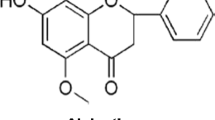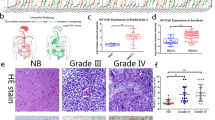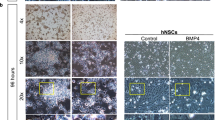Abstract
Since Notch signaling plays a critical role in stem cells and oncogenesis, we hypothesized that Notch signaling might play roles in cancer stem cells and cancer cells with a stem cell phenotype. In this study, we accessed potential functions of the Notch pathway in the formation of cancer stem cells using human glioma. Using RT-PCR, we found that most human astrogliomas of different grades expressed moderate to high level of Notch receptors and ligands. mRNA of Hes5 but not Hes1, both of which are major downstream molecules of the Notch pathway, was also detected. In human glioma cell lines BT325, U251, SHG-44, and U87, mRNA encoding different types of Notch receptors were detected, but active form of Notch1 (NIC) was only detected in SHG-44 and U87 by Western blot. Interestingly, proliferation of these two glioma cell lines appeared faster than that of the other two lines in which NIC was not detected. We have over-expressed NIC of Notch1 in SHG-44 cells by constitutive transfection to evaluate the effects of Notch signaling on glioma cells. Our results showed that over-expression of NIC in SHG-44 cells promoted the growth and the colony-forming activity of SHG-44 cells. Interestingly, over-expression of NIC increased the formation neurosphere-like colonies in the presence of growth factors. These colonies expressed nestin, and could be induced to cells expressing neuron-, astrocyte-, or oligodendrocyte-specific markers, consistent with phenotypes of neural stem cells. These data suggest that Notch signaling promote the formation of cancer stem cell-like cells in human glioma.




Similar content being viewed by others
References
Singh SK, Hawkins C, Clarke ID et al (2004) Identification of human brain tumour initiating cells. Nature 432:396–401
Galli R, Binda E, Orfanelli U et al (2004) Isolation and characterization of tumorigenic, stem-like neural precursors from human glioblastoma. Cancer Res 64:7011–7021
Wiese C, Rolletschek A, Kania G et al (2004) Nestin expression–a property of multi-lineage progenitor cells? Cell Mol Life Sci 61:2510–2522
Ignatova TN, Kukekov VG, Laywell ED et al (2002) Human cortical glial tumors contain neural stem-like cells expressing astroglial and neuronal markers in vitro. Glia 39:193–206
Artavanis-Tsakonas S, Rand MD, Lake RJ (1999) Notch signaling: cell fate control and signal integration in development. Science 284:770–776
Honjo T (1996) The shortest path from the surface to the nucleus: RBP-J kappa/Su(H) transcription factor. Genes Cells 1:1–9
Nye JS, Kopan R, Axel R (1994) An activated Notch suppresses neurogenesis and myogenesis but not gliogenesis in mammalian cells. Development 120:2421–2430
Morrison SJ, Perez SE, Qiao Z et al (2000) Transient Notch activation initiates an irreversible switch from neurogenesis to gliogenesis by neural crest stem cells. Cell 101:499–510
Hitoshi S, Alexson T, Tropepe V et al (2002) Notch pathway molecules are essential for the maintenance, but not the generation, of mammalian neural stem cells. Genes Dev 16:846–858
Genoud S, Lappe-Siefke C, Goebbels S et al (2002) Notch1 control of oligodendrocyte differentiation in the spinal cord. J Cell Biol 158:709–718
Wang S, Sdrulla AD, diSibio G et al (1998) Notch receptor activation inhibits oligodendrocyte differentiation. Neuron 21:63–75
Bao ZZ, Cepko CL (1997) The expression and function of Notch pathway genes in the developing rat eye. J Neurosci 17:1425–1434
Furukawa T, Mukherjee S, Bao ZZ (2000) Rax, Hes1, and notch1 promote the formation of Muller glia by postnatal retinal progenitor cells. Neuron 26:383–394
Gaiano N, Nye JS, Fishell G (2000) Radial glial identity is promoted by Notch1 signaling in the murine forebrain. Neuron 26:395–404
Tanigaki K, Nogaki F, Takahashi J et al (2001) Notch1 and Notch3 instructively restrict bFGF-responsive multipotent neural progenitor cells to an astroglial fate. Neuron 29:45–55
Hansson EM, Lendahl U, Chapman G (2004) Notch signaling in development and disease. Semin Cancer Biol 14:320–328
Axelson H (2004) Notch signaling and cancer: emerging complexity. Semin Cancer Biol 14:317–319
Screpanti I, Bellavia D, Campese AF (2003) Notch, a unifying target in T-cell acute lymphoblastic leukemia? Trends Mol Med 9:30–35
Shou J, Ross S, Koeppen H et al (2001) Dynamics of notch expression during murine prostate development and tumorigenesis. Cancer Res 61:7291–7297
Qi R, An H, Yu Y et al (2003) Notch1 signaling inhibits growth of human hepatocellular carcinoma through induction of cell cycle arrest and apoptosis. Cancer Res 63:8323–8329
Zheng Q, Qin H, Zhang H et al (2007) Notch signaling inhibits growth of the human lung adenocarcinoma cell line A549. Oncol Rep 17:847–852
Nicolas M, Wolfer A, Raj K (2003) Notch1 functions as a tumor suppressor in mouse skin. Nat Genet 33:416–421
Rubinstein LJ (1985) Embryonal central neuroepithelial tumors and their differentiating potential. A cytogenetic view of a complex neuro-oncological problem. J Neurosurg 62:795–805
Hemmati HD, Nakano I, Lazareff JA (2003) Cancerous stem cells can arise from pediatric brain tumors. Proc Natl Acad Sci USA 100:15178–15183
Okano H, Imai T, Okabe M (2002) Musashi: a translational regulator of cell fate. J Cell Sci 115:1355–1359
Yokota N, Mainprize TG, Taylor MD (2004) Identification of differentially expressed and developmentally regulated genes in medulloblastoma using suppression subtraction hybridization. Oncogene 23:3444–3453
Acknowledgments
This work was supported by grants from National Natural Science Foundation of China (30330550, 30425015, 30370589). H. Han is supported by the PCSIRT program (IRT0459) of the Ministry of Education of China.
Author information
Authors and Affiliations
Corresponding authors
Additional information
Xue-Ping Zhang, Gang Zheng and Lian Zou are contributed equally to this study.
Rights and permissions
About this article
Cite this article
Zhang, XP., Zheng, G., Zou, L. et al. Notch activation promotes cell proliferation and the formation of neural stem cell-like colonies in human glioma cells. Mol Cell Biochem 307, 101–108 (2008). https://doi.org/10.1007/s11010-007-9589-0
Received:
Accepted:
Published:
Issue Date:
DOI: https://doi.org/10.1007/s11010-007-9589-0




